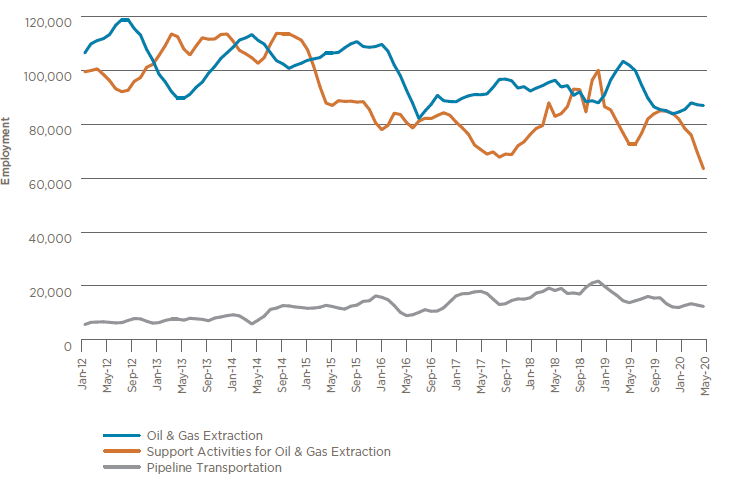Table of Contents
Key Findings
- In recent years, Canada’s oil and gas sector has been characterized by volatility and uncertainty. Several external factors have influenced these conditions, such as the global supply and demand for oil, lack of pipeline infrastructure and natural disasters, to name a few.
- The unpredictability of the sector causes unique risks and challenges that can lead to rapid fluctuations in both profits and employment over relatively short Prior to 2014, for example, oil prices were high, which made extraction profitable and led to high levels of employment. A period of sharp decline followed, beginning in the second half of 2014 and continuing through 2016.
- Most recently, oil prices plunged to record lows, sparked by a price war between Saudi Arabia and Russia with a simultaneous decrease in demand due to the COVID-19 Beginning in February 2020 and continuing through May 2020, the upstream oil and gas sector lost 8% of its jobs.
- Labour market information (LMI) is critical in this time of economic uncertainty, particularly for a sector undergoing such structural change, confronted with an aging workforce and widespread adoption of new technologies. Improvements in LMI can help those in the sector understand how to adapt to these new realities. This includes supporting workers transitioning to new opportunities by identifying the skills needed to prosper in an evolving industry.
Introduction
The COVID-19 pandemic and resulting measures to prevent its spread (e.g., social distancing, travel restrictions, school and business closures) have led to unprecedented job loss and business closures across Canada. Newly available data from the Labour Force Survey (LFS) confirm that the economic impact of this health crisis affects different sectors of the economy in unique ways. This LMI Insight Report focuses on the upstream oil and gas sector, which includes companies that explore for and produce oil and natural gas, including the oil sands, oil and gas services, and pipeline operators. This sector has been especially hit hard by plunging oil prices because of the dual impact of reduced demand due to COVID-19 coinciding with an oil price war between Saudi Arabia and Russia. Job losses in the sector have been concentrated in Alberta, Saskatchewan and British Columbia which, in 2019, accounted for 87% of oil and gas employment, 75% of which was in Alberta alone.
Oil and Gas: A Sector Under Pressure
Employment in the upstream oil and gas sector fell by 8% between February and May 2020 - a loss of over 13,000 jobs over a three-month period (see Figure 1). Although this is less than the average decline of 14% across all sectors in Canada, these job losses follow over five challenging years characterized by an unsteady but overall downward trend in total employment.
Prior to the pandemic, employment had already fallen by about 23% between August 2014 and February 2020 (see Figure 1). In other words, in fewer than five years, nearly one in four oil and gas workers lost their jobs. Then, as measures to prevent the spread of COVID-19 were implemented - travel restrictions, stay-at-home orders and closures of non-essential businesses - the employment situation deteriorated further. Demand for both oil and natural gas declined, aggravating a pre-existing supply glut and contributing to further job losses in the sector. In addition, the sector experiences a cyclical decrease in employment every spring. "Spring break-up" refers to this period when thawing frost makes the earth muddy and unsuitable for oil drilling. In the last week of May 2020, there were only 18 active drilling rigs, compared to 88 the same week in 2019.
Box 1: The Oil and Gas Sector in Canada
Canada is the fifth- and sixth-largest producer of natural gas and oil, respectively, in the world. From 2016-2018, the sector contributed an average of $8 billion in public-sector revenue annually. In 2019, it provided 5.6% ($108 billion) to Canada’s total gross domestic product. In 2017, spending in Canada’s oil and gas sector generated 178,000 direct jobs and more than 350,000 indirect jobs across the country, benefiting industries such as construction, professional, scientific and technical services, manufacturing and transportation.
Canada holds the third largest oil reserves in the world. Approximately 98% of Canada’s proven oil reserves are found in oil sands, from which extraction is expensive. The high cost of this extraction means that when oil prices fall, it quickly becomes uneconomical to produce and sell oil. Canadian heavy crude also trades at a discount to US crude because of additional cost for transportation and upgrading, making Canadian oil producers more vulnerable to international price fluctuations.
Figure 1: Employment level in the oil and gas sector declined by 23% between August 2014 and February 2020. Between February and May 2020 jobs declined by 8%. Oil and gas direct employment in Canada by sub-sectors:
Oil and Gas Extraction, Support Activities for Oil and Gas Extraction, and Pipeline Transportation.

Source: Statistics Canada Labour Force Survey and PetroLMI. The data is a seasonally unadjusted 3-month moving average.
It is likely that the effects of this pandemic on consumer demand will continue to impact the oil and gas sector over the long term. As the economy starts to reopen, energy demand from businesses like manufacturing and transportation, in addition to energy demand from developing economies transitioning from coal to natural gas, should return relatively quickly. However, long- distance passenger travel (commercial planes, trains and automobiles) will return to previous levels at a slower pace. Capital investment in the industry may also be slow to return.
An Industry Used to Uncertainty
Of course, those in the sector are familiar with its volatility. As with other primary commodity sectors, oil and gas face specific challenges and risks, including persistent price fluctuations, engineering and geological limitations, as well as Canada’s recent efforts to reduce reliance on fossil fuels due to climate change. Large shifts in employment within the sector, relative to Canada as a whole, reflect the market and business fluctuations stemming from such challenges.
From January 2012 through February 2020, for example, employment in the oil and gas sector experienced a series of losses punctuated by periods of growth (see Figure 1). Before 2014, oil prices were very high, which made extraction much more profitable. As prices continued to rise, so did commodity supply. During this period, unemployment in the industry was low while wages were high. In late 2014, with slowing demand from Asian economies, increased US oil production and the decision by other oil- producing countries to maintain output, a period of sharp decline began that continued through 2016. Faced with this excess supply and low prices, producers and service companies cut costs and laid off workers. In January 2014, the oil and gas sector employed 228,600 workers; by June 2016, it was 175,600.
As an example of the market volatility experienced during this period, in 2016 the price for West Canadian Select - the benchmark for Canada’s heavy oil - decreased 16% year over year. Following these losses, in 2017 the average price for Western Canadian Select increased by almost 32%. As a result, employment in the oil and gas sector slowly rebounded.
The Sector’s Road to Recovery
As part of Canada’s COVID-19 Economic Response Plan, the federal government announced measures to "retain and create approximately 10,000 well- paying jobs in the energy sector." The government will provide up to $1.72 billion, including funding directly to the provinces of Alberta, Saskatchewan and British Columbia to clean up orphan and inactive oil and gas wells. It will also provide up to
$750 million to create a new Emissions Reduction Fund to decrease emissions in the sector. And lastly, as part of this plan, the government will expand eligibility for the new Business Credit Availability Program. Starting with companies in Canada’s energy sector, this program is meant to support medium-sized businesses with larger financial needs to help them maintain operations and retain employees.
Even with this support, the road to recovery will be difficult. As restrictions ease and businesses slowly reopen, it is uncertain when, and to what extent, consumer demand and capital investment in the industry will recover. It will take time before people resume activities at pre-pandemic levels, such as travelling long distances, and the impact on consumer behaviour may be prolonged. Some companies may decide to shift permanently to remote work, for example, which could impact the demand for gasoline. With such uncertainty, it is difficult to predict what will happen to the Canadian oil and gas sector in the near to medium term. In the long term, oil consumption and a transition to the use of cleaner-burning natural gas are expected to grow.
The Way Forward: How LMI Can Help
Labour market information is critical in this time of economic uncertainty, particularly for an industry undergoing structural change as well as facing an aging workforce and widespread adoption of new technologies. LMI is needed to understand these forces and how they will interact with the lasting impacts of COVID-19 on the oil and gas sector. LMI will help the sector navigate and adapt to these changing conditions and emerging realities. Particularly in western provinces, some towns predominantly rely on the profitability of the oil and gas sector. Local, accessible, reliable LMI will provide oil and gas workers with knowledge and understanding about changing economic conditions, helping them, and all of us, make sense of these unprecedented times.
Acknowledgments
This LMI Insight Report was jointly prepared by PetroLMI (Lisette Cameron, Tamara Gale, Carol Howes and Breanne O’Reilly) and the staff of the Labour Market Information Council (Anthony Mantione and Zoe Rosenbaum). Your feedback is welcome. We invite you to provide your input and views on this subject by emailing us at info@lmic-cimt.ca.


